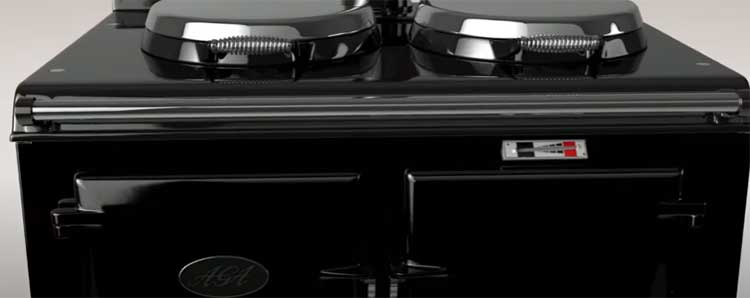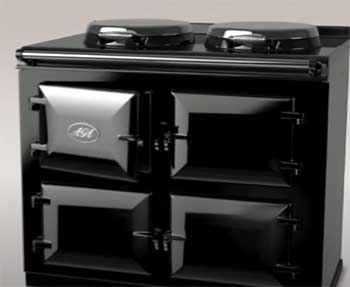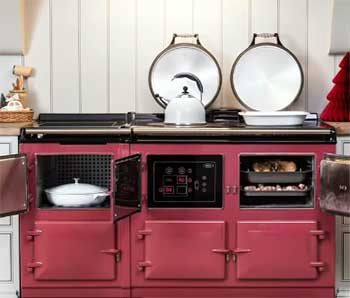I’ve always been fascinated by AGA stoves. Their iconic design, cast-iron heft, and promise of culinary magic make them a kitchen centerpiece unlike any other.
But when I first saw their price tags—starting at £5,000 and soaring past £20,000—I couldn’t help but wonder: why are AGA stoves so expensive?
In this article, I’ll explore the reasons behind their steep cost, sharing my insights from researching their craftsmanship, technology, and cultural allure. By the end, you’ll understand what makes these stoves a premium investment and whether they’re worth it for you.
Key Reasons Behind The High Cost of AGA Stoves
To understand why AGA stoves command such a premium, I’ve broken it down into several core factors. These are the elements that drive their price and set them apart from conventional ovens:
- Premium Cast-Iron Construction
- Handcrafted Excellence and Rigorous Quality Control
- Unique Heat-Storage Technology
- Multi-Functional Design with Multiple Ovens
- Energy Consumption and Modern Efficiency Features
- Brand Heritage and Prestige
- Customization and Aesthetic Appeal
- Longevity and Sustainability
- Installation and Maintenance Costs
Let’s explore each of these in detail, weaving in my own reflections on why these stoves have such a devoted following.
Premium Cast-Iron Construction

When I first laid eyes on an AGA stove, its sheer presence struck me. These aren’t flimsy appliances; they’re built from cast iron, a material that’s as robust as it is expensive.
Cast iron is renowned for its ability to retain and distribute heat evenly, which is why AGA stoves cook food so consistently. Unlike the thin steel or aluminum in most modern ovens, cast iron is heavy—often over 450 kilos for a traditional model. This weight alone hints at the material’s quality and cost.
The process of casting iron is no small feat. It requires specialized equipment and skilled labor to pour molten iron into molds, creating the stove’s sturdy frame.
Each component, from the hotplates to the oven walls, is designed to absorb heat and radiate it gently, ensuring your casseroles and roasts come out succulent. But this durability comes at a price.
The raw materials, combined with the energy-intensive casting process, significantly drive up production costs. I remember reading about how AGA stoves are made in Telford, England, where the focus on quality materials adds to the expense but also ensures a product that feels like it belongs in a professional kitchen.
What’s more, cast iron isn’t just about function—it’s about feel. When I visited a friend’s home with an AGA, I could sense the solidity just by touching it. It’s not just an appliance; it’s a statement.
But that statement comes with a hefty price tag, as the cost of premium materials like cast iron is a major reason why AGA stoves don’t come cheap.
Handcrafted Excellence and Rigorous Quality Control
As I dug deeper into AGA’s manufacturing process, I was struck by the level of craftsmanship involved. Each AGA stove is hand-assembled at their factory in Shropshire, England. This isn’t a mass-production line churning out thousands of units a day.
Skilled artisans carefully construct each stove, ensuring every detail—from the alignment of the hotplates to the application of the enamel finish—is flawless.
The enameling process alone is a labor of love. It takes up to three days to apply multiple coats of vitreous enamel, which gives AGA stoves their glossy, durable exterior. I can still picture the cream-colored AGA in my friend’s kitchen, its shine catching the light like a polished gem.
This enamel isn’t just for looks; it’s heat-resistant and built to withstand decades of use. But achieving that finish requires precision and time, both of which add to the cost.
Then there’s the quality control. Every AGA undergoes rigorous checks to ensure it meets the brand’s exacting standards. I learned that defective units are virtually unheard of because the company is so meticulous.
This commitment to perfection means higher production costs, but it also means you’re getting a stove that’s built to perform flawlessly. For me, this hands-on approach explains why AGA stoves feel so special—and why their price reflects the care put into every unit.
Unique Heat-Storage Technology

One of the most intriguing aspects of AGA stoves is their heat-storage technology. Unlike conventional ovens that heat up and cool down with each use, traditional AGA stoves are designed to stay on 24/7, maintaining a constant heat source.
This was the brainchild of Gustaf Dalén, the Nobel Prize-winning Swedish physicist who invented the AGA in 1922 after noticing how exhausting cooking was for his wife. Blinded by an accident, he set out to create a stove that was easy to use and versatile, and the result was a cooker that stores heat in its cast-iron body.
This technology is a game-changer. The stove’s heavy frame absorbs heat from a low-intensity source, then radiates it evenly to the ovens and hotplates.
When I first used an AGA, I was amazed at how I could slide a roast into the roasting oven, bake bread in the baking oven, and simmer a sauce on the hotplate—all at the same time, without adjusting dials.
The radiant heat locks in moisture and flavor, making food taste incredible. My friend swore her AGA-made casseroles were unmatched, and I have to agree.
But this unique system comes with a cost. The engineering required to maintain consistent heat across multiple ovens and hotplates is complex. It demands high-quality materials and precise construction, both of which drive up the price.
Modern AGA models, like the eR3 and eR7 series, have introduced features like programmable timers and individual oven controls to improve efficiency, but even these advancements require significant research and development. For me, this technology is a big part of what makes AGA stoves so expensive—and so beloved.
Multi-Functional Design with Multiple Ovens
One of the standout features of AGA stoves is their multi-oven design. A traditional AGA might have a roasting oven, a baking oven, a simmering oven, and sometimes a warming oven, each set to a specific temperature.
This setup allows you to cook multiple dishes simultaneously without the temperature fluctuations you’d get in a conventional oven. I remember hosting a dinner party at a house with an AGA, where we roasted a chicken, baked a cake, and kept side dishes warm—all in one go.
It felt like having a professional kitchen at my fingertips.
Larger models, like the five-oven eR7, take this versatility further, offering slow-cooking ovens and even induction hobs. The ability to grill, bake, roast, simmer, and more in one appliance is a huge draw, but it’s also a costly one.
Each oven requires its own heating elements and insulation, and the engineering to ensure they all work harmoniously is no small task. Plus, the cast-iron construction needed to support these functions adds to the material costs.
I’ve found that this multi-functional design is a double-edged sword. It’s incredibly convenient for serious cooks, but it also means you’re paying for a level of complexity that simpler ovens don’t require.
For someone like me, who loves experimenting in the kitchen, the ability to multitask with an AGA is a dream—but it’s a dream that comes with a premium price.
Energy Consumption and Modern Efficiency Features

One of the biggest criticisms I’ve heard about AGA stoves is their energy consumption.
Traditional models, designed to be always on, can use significant amounts of fuel—whether gas, oil, or electricity.
For example, a two-oven gas AGA might consume 425 kWh per week, compared to a standard gas oven’s 2.6% of that.
When I first learned this, I was shocked. Who wants to pay that much to run a cooker?
But AGA has responded to these concerns with newer models like the Total Control and eR7 series, which allow you to turn ovens and hotplates on and off as needed. These models heat up in as little as 8-10 minutes, saving up to 50% of the energy used by traditional AGAs.
I spoke to a homeowner who switched to an electric eR3 model and paired it with solar panels, reducing her running costs significantly. Features like programmable timers and “slumber” modes further help manage energy use, but developing these technologies isn’t cheap.
Still, even with these advancements, running an AGA can be pricier than a conventional oven. Electricity costs around 25.73p per kWh, and while gas and oil models are often cheaper to run, their costs depend on your location and supplier.
For me, the trade-off is the convenience and quality of cooking, but the energy factor is undeniably a contributor to the overall expense of owning an AGA.
Brand Heritage and Prestige
There’s something undeniably prestigious about owning an AGA. Invented by Gustaf Dalén, the AGA brand has a century-long legacy of innovation and quality. It’s not just a cooker; it’s a symbol of culinary excellence and traditional craftsmanship.
When I visited a country home with an AGA, I could feel its status as the heart of the kitchen. It’s no wonder the term “AGA saga” was coined to describe novels set in affluent British homes—AGAs are synonymous with a certain lifestyle.
This heritage adds to the cost. The AGA brand has cultivated a reputation for excellence, and owning one is often seen as a status symbol. I’ve noticed that AGA owners are fiercely loyal, often describing their stoves as family heirlooms.
The brand’s history, combined with its association with high-end kitchens, allows AGA to command a premium price. It’s not just about cooking; it’s about owning a piece of history. For me, this prestige is part of the allure, but it’s also a reminder that you’re paying for more than just an appliance.
Customization and Aesthetic Appeal

AGA stoves are as much about style as they are about function.
Available in up to 17 vibrant enamel colors—from classic cream to bold red—they’re designed to be a focal point in any kitchen.
I remember walking into a showroom and being dazzled by the range of finishes, each one more striking than the last.
You can even customize your AGA with options like induction hobs or specific oven configurations, making it feel like you’re designing a bespoke piece of furniture.
This level of customization isn’t cheap. The enameling process, as I mentioned earlier, is time-intensive, and custom colors or features require additional labor and materials.
Plus, AGA stoves come in various sizes, from the compact 60cm AGA 60 to the expansive 210cm eR7, each tailored to different needs. The ability to choose your color, size, and features feels like buying a luxury car, and like a car, those options drive up the price.
For me, the aesthetic appeal is a huge draw, but it’s clear that this level of personalization contributes significantly to the cost.
Longevity and Sustainability
One of the most compelling reasons for an AGA’s price is its longevity. These stoves are built to last decades, often outliving their owners.
I read about a competition in 2009 where AGA celebrated its 80th anniversary by searching for the oldest stove still in use—many were over 50 years old and still going strong.
This durability is thanks to the cast-iron construction and meticulous craftsmanship, but it also means you’re investing in a product that won’t end up in a landfill.
AGA also emphasizes sustainability. Their stoves are nearly 100% recyclable, often made from recycled materials like old car gearboxes or lamp posts. I find this aspect particularly appealing, as it aligns with my desire to make environmentally conscious choices.
However, creating a product that’s both durable and sustainable requires significant investment in materials and processes, which adds to the cost. For me, the idea of a stove that could be passed down to my kids makes the price feel a bit more justified.
Installation and Maintenance Costs
Finally, I can’t overlook the cost of installing and maintaining an AGA. These stoves are massive, often requiring cranes or specialized equipment to move them into place.
I read about one owner who had to winch their AGA through a window because it wouldn’t fit through the door! Installation costs can range from £150 to £500, depending on the model and complexity, and it’s crucial to use a qualified professional to ensure safety and efficiency.
Maintenance is another factor. While AGAs are low-maintenance due to their simple design, traditional models require occasional servicing, especially if they run on gas or oil.
Modern electric models are easier to maintain, but any repairs can be costly due to the stove’s complexity. For me, these additional costs were a reality check—buying an AGA isn’t just about the sticker price; it’s about the long-term commitment.
But for those who love their AGA, these costs are a small price to pay for the joy it brings.
Frequently Asked Questions (FAQ)
AGA stoves are renowned for their cast-iron construction, radiant heat cooking, and multi-oven design, which allow for versatile, flavorful cooking. Their iconic style and longevity make them a kitchen centerpiece.
The 7-minute rule refers to the time it takes for modern AGA models, like the eR3 or eR7, to heat up their hotplates (8-10 minutes) or ovens, offering faster, more energy-efficient operation compared to traditional always-on models.
It depends on your needs. If you value premium cooking, durability, and a status symbol, an AGA’s quality and versatility can justify the cost. Budget-conscious cooks might prefer a conventional oven.
Running costs vary by model and fuel. A traditional gas AGA might cost £100-£150 per month, while modern electric models with efficiency features can cost less, especially with renewable energy sources.
Conclusion: Is An AGA Worth It For You?
As I’ve explored the reasons behind the high cost of AGA stoves, I’ve come to appreciate their unique blend of craftsmanship, technology, and heritage. From the premium cast iron to the hand-assembled quality, every aspect of an AGA is designed to deliver exceptional performance and longevity.
Yes, they’re expensive—often costing between £5,000 and £20,500, plus installation and running costs—but for many, they’re more than just a cooker. They’re a lifestyle choice, a statement of quality, and a source of kitchen warmth.
For you, the decision comes down to your priorities. If you’re a passionate cook who values versatility, durability, and timeless design, an AGA might be worth the investment.
But if budget or energy efficiency is your main concern, you might want to explore more affordable alternatives. Whatever you choose, I hope my journey into the world of AGA stoves has helped you understand why they cost so much—and why so many people fall in love with them.
